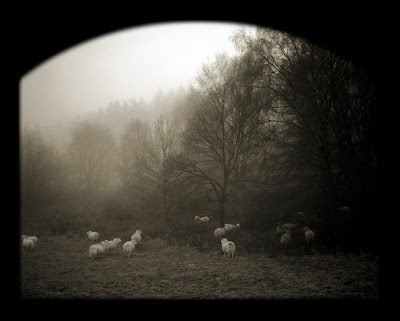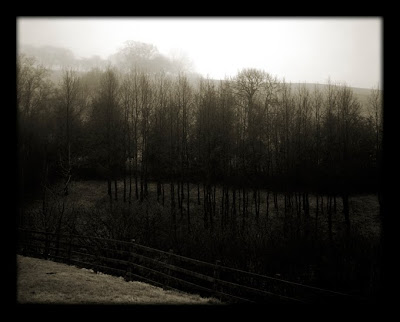 Near Llandrindod Hall Farm, Powys
Near Llandrindod Hall Farm, PowysIn a recent comment on the
Brown Clee post, Gavin asked an interesting question. He wondered why I seemed to feel differently about those photographs taken at Brown Clee compared with, say, those that make up other "landscape" series, e.g. the ones I made at Mottisfont Abbey. I began to reply as another comment, but decided it was worth a post in its own right.
So, why
do I regard some of my photographs differently to others?
Well, on one level, of course, we all do. An obvious reason is
purpose. If, for example, I photograph a plate which I intend to sell on Ebay, my primary purpose is simply to show what the plate looks like. But -- if I have any idea what I'm doing -- I will also have a strong, secondary purpose, which is to make it look as attractive as possible to prospective buyers. And if I were a professional advertising photographer, I'd use all sorts of tricks to
sex up that plate, to convince the target demographic that buying this plate is an essential lifestyle or status move. My intention would not so much be to portray the plate, or my feelings about the plate, as to stimulate the desire of an imagined purchaser of the plate.
The same goes for landscape: most landscape photography is pretty instrumental, too. "Look, here's a landscape -- isn't it magnificent? Oh, and look -- here's a flight schedule!". Skilled landscape photographers deploy a similar bag of tricks to the advertising photographer. The work of a successful landscapist like Charlie Waite is all about using viewpoint, time of day, isolation of subject, graduated filters, choice of lens, composition, etc., to produce a highly crafted view, primarily intended to appeal to the viewer's eye. Such work is rarely either very expressive of the person behind the camera, however, or the reality on the ground. It's rather classical in spirit -- pleasing variations within mutually-acceptable guidelines. One thinks of Alexander Pope:
True Wit is Nature to Advantage drest,
What oft was Thought, but ne'er so well Exprest,
Something, whose Truth convinc'd at Sight we find,
That gives us back the Image of our Mind.
Alexander Pope, An Essay on Criticism
It's often work of this sort that attracts people to photography in the first place. You see it everywhere in books and magazines -- lavender fields in Provence, misty dawns in the Pyrenees, autumnal oak groves in the Dordogne, all catching that warm "magic hour" sunlight
just so. But, although I respect the skill, that is not the kind of photography I admire or aspire to produce. Not least because so many others do.
 St. Audrey's Bay, Somerset
St. Audrey's Bay, SomersetSo, what is? I have already mentioned the work of Thomas Joshua Cooper several times. Cooper is the ultimate romantic landscape photographer, a driven man, fulfilling his unique vision in
conditions of sometimes melodramatic peril, lugging his antique Agfa view camera into the remotest corners of the Atlantic coast or onto Norwegian glaciers, sticking religiously to a "one lens, one exposure" mantra. You may find his work too dark, too samey, too mysterious, even rather frightening. TJC couldn't care less.
Or perhaps Susan Derges. Obsessed with the camera-less photographic image, she is to be found at midnight when there is a full moon, dunking large sheets of Cibachrome into the tide on Devon beaches or into the wooded streams of Dartmoor, like a priestess of some sort of hi-tech haruspicy. It does sound utterly mad, but what sensational, unique, inimitable, expressive images result! I doubt Susan Derges cares much what other people think of her work or her methods.
Or Jem Southam. In some ways the mirror image of Thomas Joshua Cooper, Jem is the ultimate post-romantic landscape photographer, a driven man, fulfilling his unique vision in
conditions of sometimes comic bathos, lugging his view camera and ladder repeatedly into the same familiar corners of the English south coast, sticking religiously to an "overcast light only, absolutely no Sturm and Drang!" mantra. You may find his work too blandly-lit, too samey, too mysterious, even disturbing. Jem is amused by, but indifferent to, his detractors.
But, seeing as this is my blog, what about me? Apart from admiring the work and attitude of certain outstanding contemporary photographers, what differentiates those images that I hoard into series, and those I regard as "one offs"?
The simplest answer is that I like there to be a genuine coherence about my series / sequences, usually one combining unities of time, place, approach and technique. The underlying project has to be there. For example, the images of the River Test at Mottisfont were the result of a two year project, with access granted to the grounds in the closed season, using the same camera and film. Their coherence is not accidental. Whereas those Brown Clee photographs are of a place I've only visited twice, under particularly strained emotional conditions, and using a technique (scanned 120 film) which I have now pretty much abandoned. If there were, say, a few hundred of them there might be some sort of highly condensed sequence to be extracted. But there aren't: you only get 12 images on a 120 roll of film, and I think I shot a couple of rolls on each visit.
Now, it is true that I have a vast hoard of 6x6 and 6x4.5 negatives which remain largely unscanned. Buried in there are plenty of classic landscape "views" with enough edge and interest to warrant pulling together, one day, as a sort of retrospective series, and the Brown Clee images might find a place there. But a lot of them are what I refer to, semi-facetiously, as "holiday snaps"; I went to this place, I saw this view, I took this photograph. For example, I have quite a large body of work from our annual visits over the last 30 years to the Welsh Borders. But it doesn't cohere and, above all, it doesn't penetrate beneath the superficial attractions and quirks of the area.
I'm never convinced by the kind of results I get from brief visits. I'd never make a good photojournalist. That's what I mean when I refer to these images as "holiday snaps". We'll always be mere visitors in Wales, unless and until we decide to retire there, and have to cope with what really happens in that wonderful landscape: the limited shopping facilities, the rural postal service and health service, the absence of mobile phone and broadband coverage, the decline of the hill farming economy, the ageing population, locals' resentment of incoming retirees, etc., etc.
Then I may finally have something to say about the place!
And it is important to me that I have something to say, that I am not wasting your time and mine if I ask for your attention. And that "something" has -- for me -- to be more than simply calling attention to or illustrating something as self-evident as, let's say, the beauty or magnificence of a landscape "to Advantage drest". You can do that for yourself or, if not, buy books and postcards. What I am interested in is the expressive, narrative and poetic possibilities that images combined in sequences can generate; I'm just not so interested in the kind of stand-alone imagery that someone might use as their PC wallpaper or buy as a greetings card.
So, yes, although I like those Brown Clee photographs -- I wouldn't have shown them otherwise -- they do not really satisfy me. They lack a proper context, and they need the stimulating company of other photographs; it is not yet clear to me whether I can provide either. And I certainly can't imagine anyone wanting to make them into greetings cards.
 Issigeac, Dordogne, France
Issigeac, Dordogne, France
























